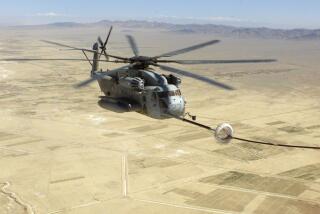Marines, Afghan soldiers attack Taliban stronghold
- Share via
Reporting from Camp Leatherneck, Afghanistan — Hundreds of U.S. Marines and Afghan soldiers descended on a nearly empty city in southern Afghanistan on Friday to cut off supply routes for Taliban fighters who have taken refuge in the area.
The troops want to starve out the insurgents holed up around Now Zad, which was once a vibrant city of 30,000 but now is a virtual ghost town because years of fighting.
The assault in Helmand province, named Cobra’s Anger, may prove to be a warmup for a larger, more complex and more dangerous assault on Marja, a town to which many Taliban fighters and narcotics middlemen fled after Marines descended on nearby villages this summer.
In Now Zad, Marines had to contend with roadside bombs that Taliban militants buried in anticipation of the Americans’ arrival. Even more such bombs are expected to await troops in Marja.
“Marja is that last major sanctuary in Helmand province, the last place where the enemy has freedom of movement,” said Brig. Gen. Larry Nicholson, commander of the 2nd Marine Expeditionary Brigade. “We’re going to take that away from him.”
Nicholson compared the prospective battle in Marja to the fight in late 2004 to clear barricaded insurgents from the Iraqi city of Fallouja.
But Marja is split up by irrigation canals that will make moving troops and vehicles difficult. A vigorous house-to-house assault by Marines on a town also would raise the specter of civilian casualties, an issue that has strained relations between Western forces and the government of Afghan President Hamid Karzai.
Still, Nicholson said, the only issue is when Marja will be emptied of insurgents. No timetable has been announced.
In Now Zad, Marines of the 3rd Battalion, 4th Regiment, based in Twentynine Palms, and the 3rd Reconnaissance Battalion, based in Okinawa, Japan, met only light opposition, which may not be the case in Marja.
No Marine casualties were reported in the first stage of the Now Zad assault. Some of the troops descended on key supply routes via the Marines’ tilt-rotor Osprey aircraft.
In July, about 4,500 Marines quickly deployed to Helmand province, which has been a Taliban stronghold and a major poppy-growing region. After weeks of firefights, militants were pushed out of villages.
U.S. and British teams then began an aggressive counterinsurgency program -- building roads, cleaning irrigation ditches and repairing schools, clinics and mosques. Councils of elders were organized in an effort to give the Afghans a sense of confidence in their local government.
Marja has functioned as a haven for Taliban fighters, with assassins returning to the villages by night. Two members of the nearby Nawa district council were assassinated, with Taliban fighters as the chief suspects.
Clearing Marja, Nicholson said, would add to the progress the U.S. has made in many areas. “We want to keep that momentum going,” he said.
More to Read
Sign up for Essential California
The most important California stories and recommendations in your inbox every morning.
You may occasionally receive promotional content from the Los Angeles Times.












